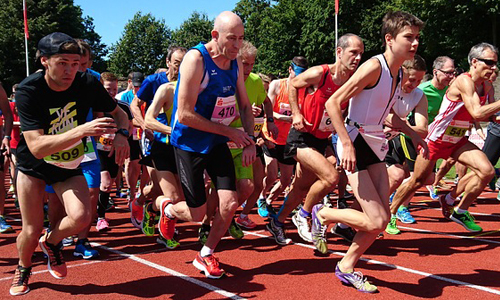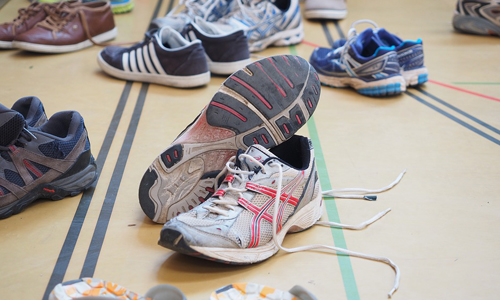The Anatomy of a Running Shoe Understood
Author

Mike has a real passion for cycling, hiking and just generally being outdoors. Being from Warrington, he is only a few hours away from North Wales, The Peak District, Yorkshire and the Lake District. He has climbed Mount Kilimanjaro and done a lot of the mountains in the Lake District. His new passion is walking his dog and enjoying a pint at the end.
We often find ourselves clueless when we go shopping for running shoes. What shoes are good for my purpose? How comfortable are they? How well would they absorb shocks? etc. are the questions that come to our minds. Don’t worry anymore, the information ahead will provide you with all you need to know about the running shoes, their anatomy and features.
Running Shoes- The Anatomy
To buy a shoe that fits your needs and feet, you need to understand the terminology it comes with. The terms explained ahead will guide you through the anatomy of the running shoe.
Shoe Upper
Upper: The upper of the shoe is what you see first. This is the part that has the laces, collar and the tongue. The best running shoe is the one with a mesh upper that increases the ventilation around your foot, keeping it fresh longer. However, in case you are looking for the trail shoes - running or hiking, the ones with higher durability such as leather or synthetic overlays on top will help protect you from trail hazards.
Collar: The part surrounding the ankle of the shoe is the collar. Always look for a cushioned collar, ones that are lined with mesh so the shoe is breathable and moisture free.
Eyelets: These are the holes on the upper of the shoe through which laces go through. These are above the tongue and can be tied with different styles of laces and techniques.
Tongue: The tongue of the shoe is the centre-top part that helps the foot slide in easily and is padded to avoid the laces entangling with the toes. However, trail and hiking shoes come with gusseted tongues which keep trail debris and moisture out.
Toe Cap or Toe Bumper: This is technically a part of the toe box, the area where the toes are housed. It is the extra padding at the tip of the shoe that protects the toes from impact. For protecting the feet from trail debris, the trail-running shoes tend to have beefier toe caps as compared to running shoes.
Under Foot
Insole/ Footbed: The insole is a removable insert above the midsole that increases comfort and provides anatomically right support and cushioning to the feet.
Midsole: Sandwiched between the insole and the outsole, the midsole has a great importance in a running shoe. They not only absorb possible shocks but also provide support with air or gel cushioning. They are made with ethyl vinyl acetate EVA foams which are dense and hard foams that absorb shocks on the foot.
Outsole: The outsole is located at the bottom most part of the shoe and helps in providing traction on the ground and flexibility. While looking for a running shoe, make sure to look for ones that add durability like carbon rubber or blown rubber outsoles.
Around the sides and the middle
Heel counter: The heel counter is placed just below the Heel Tab or Achilles Notch. It is  where the collar ends inside or outside the back of the shoe. It is designed to take the shape of the bearer’s heel and hold the shoe in place.
where the collar ends inside or outside the back of the shoe. It is designed to take the shape of the bearer’s heel and hold the shoe in place.
Side/ Quarter Panels: These are a part of the upper but are incorporated to reinforce overlays for added durability and stability.
Toe Spring: This part of the shoe is not often highlighted but supports the toes from the front as it arcs upward to aid forward momentum.
Hopefully, the next time you go to buy running shoes, you would know exactly what you are looking for and how you can find a comfortable fit for your feet.
Author

Mike has a real passion for cycling, hiking and just generally being outdoors. Being from Warrington, he is only a few hours away from North Wales, The Peak District, Yorkshire and the Lake District. He has climbed Mount Kilimanjaro and done a lot of the mountains in the Lake District. His new passion is walking his dog and enjoying a pint at the end.
Categories
- Sport (28)
- Product Reviews (3)
- Team Outdoor Look (7)
- Mike Wild (2)
- Mike Payton (2)
- Suse Hammond-Pears (3)
- Snowboarding (12)
- Latest Offers (105)
- Shop Talk (1)
- Competitions (7)
- Walking (413)
- Lifestyle Fashion (8)
- Travel (86)
- Kit Guides (176)
- Workwear Clothing (6)
- Safety Workwear (4)
- Health/Fitness (289)
- Skiing (91)
- Great Outdoors (1316)
- Cycling (92)
- January 2025
- December 2024
- November 2024
- October 2024
- September 2024
- August 2024
- July 2024
- June 2024
- May 2024
- April 2024
- March 2024
- February 2024
- January 2024
- December 2023
- November 2023
- October 2023
- September 2023
- August 2023
- July 2023
- June 2023
- May 2023
- April 2023
- March 2023
- February 2023
- January 2023
- December 2022
- November 2022
- October 2022
- September 2022
- August 2022
- July 2022
- June 2022
- May 2022
- April 2022
- March 2022
- February 2022
- January 2022
- December 2021
- November 2021
- October 2021
- September 2021
- August 2021
- July 2021
- June 2021
- May 2021
- April 2021
- March 2021
- February 2021
- January 2021
- December 2020
- November 2020
- October 2020
- September 2020
- August 2020
- July 2020
- June 2020
- May 2020
- April 2020
- March 2020
- February 2020
- January 2020
- December 2019
- November 2019
- October 2019
- September 2019
- August 2019
- July 2019
- June 2019
- May 2019
- April 2019
- March 2019
- February 2019
- January 2019
- December 2018
- November 2018
- October 2018
- September 2018
- August 2018
- July 2018
- June 2018
- May 2018
- April 2018
- March 2018
- February 2018
- January 2018
- December 2017
- November 2017
- October 2017
- September 2017
- August 2017
- July 2017
- June 2017
- May 2017
- April 2017
- March 2017
- February 2017
- January 2017
- December 2016
- November 2016
- October 2016
- September 2016
- August 2016
- July 2016
- June 2016
- May 2016
- April 2016
- March 2016
- February 2016
- January 2016
- December 2015
- November 2015
- October 2015
- September 2015
- August 2015
- July 2015
- June 2015
- May 2015
- April 2015
- March 2015
- February 2015
- January 2015
- December 2014
- November 2014
- October 2014
- September 2014
- August 2014
- July 2014
- June 2014
- May 2014
- April 2014
- March 2014
- February 2014
- January 2014
- December 2013
- November 2013
- October 2013
- September 2013
- August 2013
- July 2013
- June 2013
- May 2013
- April 2013
- March 2013
- February 2013
- January 2013
- December 2012
- November 2012
- October 2012
- September 2012
- August 2012
- July 2012
- June 2012
- May 2012
- April 2012
- March 2012
- February 2012
- January 2012
- December 2011
- November 2011
- October 2011
- September 2011
- August 2011
- May 2010
- April 2010
- March 2010
- February 2010
- January 2010
- November 2009
- October 2009
- September 2009
Submit a Comment